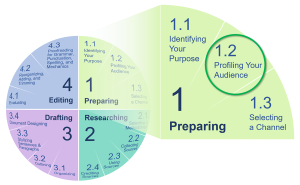2.2: Analyzing Your Audience
Learning Objectives
 2. Analyze primary and secondary audiences using common audience-profiling techniques.
2. Analyze primary and secondary audiences using common audience-profiling techniques.
3. Identify techniques for adjusting writing style according to audience size, position relative to you, knowledge of your topic, and demographic.
4. Write professional and discipline-specific documents that are clear, concise, correct, and visually engaging (ENL1004 Course Learning Outcome 1).
5. Apply appropriate planning strategies to communicate purpose and message effectively (ENL1004 Course Learning Outcome 1.1).
Just as the first commandment in any business could be “Know thy customer” (§1.5, para. 2), so the first in communication is “Know thy audience.” So, just as any business thrives or dies by how well it supplies a customer demand, any act of communication’s success depends entirely on how well the sender tailors it to meet the needs and expectations of the audience. Sometimes that audience is a person or group you know, sometimes not, but you must always adjust your message content and style according to what you know or can guess about them. You wouldn’t speak to a customer approaching you for the first time the same way you would a familiar co-worker, nor would you speak to your manager exactly the same way you would with either of the others (depending on the type of manager you have and rapport you develop with them). In each case, you adjust the level of detail in your content, as well as your tone, word choices (diction), grammar, and overall style (formal or casual; see §4.5.1)—otherwise known as code-switching (“Code-switching,” 2025)—based on how you’ve profiled your audience.

Profiling or analyzing your audience takes skill and consideration. When you sit down to write or you’re about to speak, ask yourself the following questions so that you fully understand the relevant factors that affect the context of your communication with your audience:
- How big is my main audience? Is it one person, two, a few, several, a dozen, dozens, hundreds, or an indeterminately large number (the public at large)?
- Who might my secondary or tertiary audiences be—e.g., people you can see CC’d (“carbon copied”) on an email or people you can’t because they are BCC’d (“blind carbon copied”—i.e., people added whom you can’t see because the sender wants to protect their privacy) or could be forwarded your email without you knowing?
- What is my professional or personal relationship to them relative to their position/seniority in their organization’s hierarchy?
- How much do they already know about the topic of my message?
- What is their demographic—e.g., their age, gender, cultural background, educational level, and beliefs?
The following subsections delve further into these considerations to help you answer the above questions in specific situations.
- 2.2.1: Writing for Audiences of Various Sizes
- 2.2.2: Considering Secondary and Other Audiences
- 2.2.3: Considering Your Relationship to the Audience and Their Position
- 2.2.4: Considering Your Audience’s Level of Knowledge
- 2.2.5: Considering Your Audience’s Demographic
2.2.1: Writing for Audiences of Various Sizes
Writing to one person is a relatively straightforward task, but you must adjust your writing style to accommodate a larger audience. When emailing one person, for instance, you can address them by name in the opening salutation and continue to use the second person singular you throughout. When addressing two or three people, perhaps for a project that involves 2-3 partners (including you, totalling 3-4 altogether), you would likewise address them each by name, either in alphabetical order or in order of who is primarily involved and then descending in size of contribution. Past four, however, you may start to use collective salutations such as “Hello, team,” or “Hi, all.” Luckily, the second-person pronoun you is the same in both singular and plural forms. For such small audiences, your style can generally follow the conversational rapport you’ve developed with them, whether that be formal or informal, serious or humorous, literal or expressive, and so on.

The larger the group, however, the more general and accessible your language must be. When writing for an indeterminately large group such as the consumer public, say in a blog on your company’s website, your language must be as plain and accessible as possible. In Canada, the public includes readers who will appreciate that you use simple words rather than big, fancy synonyms because English may be their second or third language. Indeed, the Government of Canada has published the following handy guide for how to write accessibly in plain language:
Use Familiar language, known expressions, and illustrations
Tips:
- Choose familiar, everyday words and expressions (e.g., “quite” rather than “relatively”)
- Define specialized words and difficult concepts, illustrate them with examples, and provide a glossary when it is necessary to use several such words/concepts
- Choose concrete rather than abstract words and give explicit information (e.g., “car crash” rather than “unfortunate accident”)
- Avoid jargon and bureaucratic expressions
- Use acronyms with care and only after having spelled them out
- Choose one term to describe something important and stick to it; using various terms to describe the same thing can confuse the reader
- Add tables, graphs, illustrations and simple visual symbols to promote understanding
Examples:
Instead of: Use: 23-01-2003 January 23, 2003 We can reasonably speculate that young adults want to hear about terrorism and security issues. Young adults are likely to want to hear about terrorism and security. Tax payers are encouraged to e-file their tax returns. Did you know that you can file your tax returns on the internet?
To reinforce these lessons on plain language, you can examine the US Government’s Federal Plain Language Guidelines resource and the BC provincial government’s PDF of plain language exercises.
Likewise, your writing to large audiences should not reveal any bias in terms of gender, ethnicity, age, ability, or orientation lest you offend members of that group. Because using masculine singular pronouns like he, his, and him would exclude the female half of your audience, for instance, use gender-neutral plural pronouns they, their, and them instead; using those plural pronouns for singular situations has also become acceptable. When identifying people by their role, use non-gender-exclusive equivalents. See Queen’s University’s Inclusive Language guide for more on avoiding bias in your writing.
The larger the group, the more careful you must be with using unique English idioms as well. Idioms are quirky or funny expressions we use to make a point. If you wanted to reassure a customer who recently immigrated from North Africa, for instance, before explaining an automotive maintenance procedure unique to Canadian winter weather and said, “Hey, don’t worry, it’ll be a piece of cake,” they may be wondering what eating cake has to do with switching to winter tires. Likewise, if you said instead that it’ll be “a walk in the park,” they would be confused about why they need to walk through a park to get their radials switched. Calling it a “cakewalk” wouldn’t clarify much, either. These expressions would be perfectly understood by anyone who has been conversing in English for years because they would have heard them many times before and used them themselves. In the case of using them around EAL (English as an additional language) speakers, however, you and your audience would both benefit from you using the one word that these idioms translate as: easy. Again, the whole goal of communication is to be understood, so if you use idioms with people who haven’t yet learned them, you will fail to reach that goal. See The Idioms website for a wide selection of English idioms and their meanings.
2.2.2: Considering Secondary and Other Audiences
Always consider secondary or even tertiary audiences for any message you send. Primary audiences are those you directly address; if you’re the sender of a message, they’re the main receiver—whereas secondary audiences are those you invite to monitor your communication (e.g., by CC’ing in an email message). Though you know who your primary and secondary audiences are, you have little-to-no control over unknown tertiary audiences that see your message unless confidentiality can be somehow guaranteed. Tertiary audiences are those who receive messages not originally intended for them, such as nearby people overhearing a conversation or people forwarded emails or voicemail messages without the sender’s knowledge or consent. With social media, screenshots of written communication assumed to be private can be posted and go viral among enormous tertiary audiences, sometimes with disastrous consequences for the people involved in the original communication. Even what you say can simply be reported to tertiary audiences and be believed if the reporter is considered credible. Before sending that email or text, leaving that voicemail in professional situations, or even saying something outrageous, always consider how it would go over with your manager, your family, or a jury if it was forwarded, posted, or otherwise reported.

You may think that you have a right to privacy in communication, and you do to some extent, but employers also have certain rights to monitor their employees and ensure company property (including cyber property) isn’t being misused (Office of the Privacy Commissioner of Canada, 2023; Government of Ontario, 2024). If a disgruntled employee, for instance, uses their company email account in communication with a rival company to prove that they are part of a target company, then uses that email account to sell trade secrets before leaving for another job, the employer has a right to read those emails and take measures to protect against such corporate espionage. Following the law, the employer merely needs to be transparent about what and how they are monitoring employees. Because company emails can be stored on the organization’s servers, always assume that any email you send using a company account can be retrieved and read by tertiary audiences. If you are at all concerned that an email might hurt you if it fell into the wrong hands, arrange to talk to your primary audience in person or in some other channel that can’t be so easily monitored.
Even in more harmless and routine information sharing, you must adjust your message for any known or unknown secondary audiences. If you CC your manager or other relevant parties in an email, for instance, you must be more careful than you otherwise would be to ensure that your message is completely free of any language or content that would make you or them look bad. Your style should be a little more formal and you must proofread more thoroughly to avoid writing errors that make you appear uneducated and sloppy, which no employer wants to pay for.
Even if you don’t yourself designate CC recipients, as explained above, someone else could. Say you’re in a back-and-forth email thread with a co-worker as you collaborate on a project. You’re making good progress at first, but your partner begins slacking off and your emails become progressively impatient, even angry and threatening. Frustrated, you use accusatory and inappropriate language that, in retrospect, you’re not proud of. However, moving forward, you enlist another collaborator who, as drafts are exchanged with finishing touches towards the end of the thread, CC’s your manager to show that the work is completed. Seeing the lack of professionalism in your exchanges with the previous collaborator when trying to assess what went wrong with the original assignment, your manager now sees that you must share some of the blame for your poor communication choices.
In the above case, heeding the advice given in §6.1.11: Before Sending Your Email and §10.2: Professionalism, Etiquette, and Ethical Behaviour would have helped avoid whatever professional consequences would follow this unfortunate indulgence in flaming (hostile and offensive online writing) and apparent naïveté or lack of concern about the fact that anything you post online can later be seen and judged. Even if you delete an email, it still exists on a server somewhere and can be retrieved. So, whenever you write online in workplace circumstances, picture a manager or your boss’s boss sitting beside you and judging the professionalism of your message as you write no matter who the primary audience is.
Of course, netiquette (see §6.2: Netiquette and Social Media) also requires that you be careful whom you CC on messages. Often managers will be interested in what’s going on with certain projects and would like to be CC’d to be kept in the loop. In such cases, clarify with them to what extent they want to see the progress; CC’ing them on every little exchange will just waste their time and annoy them by flooding their inbox. Involving them only when important milestones are met, however, will likely be much appreciated.
2.2.3: Considering Your Relationship to the Audience and Their Position
Just as you might wear your best clothes for an important occasion like a job interview or wedding, you must respectfully elevate the formality of your language depending on the perceived importance of the person you’re communicating with. As said above, if you’re writing to your manager about something very important, something that will perhaps be read closely by others or even many people, you would be more careful to write in a professional style and fully proofread your email than you would if you were writing a co-worker who doesn’t really care about the odd spelling mistake. Employers or clients tend to be judgmental and can pigeonhole you as sloppy and careless about details if you send them a poorly written email. All employers want to see that their employees are detail-oriented for the money they’re paying them, especially if the employees’ writing represents the company and affects its reputation in the judgmental eyes of clients and other stakeholders (Wiens, 2012). Ultimately, you don’t want to embarrass yourself and your company, nor lose out on professional opportunities with glaring writing mistakes that more thorough proofreading could have caught and corrected.
Formality in writing requires correct grammar and punctuation (see Ch. 5 on the editing stage of the writing process), whereas more casual writing takes liberties such as using sentence fragments and contractions. If writing a quick information-sharing email to a familiar, friendly co-worker, for instance, you might say, “Just a quick heads-up: don’t forget to submit your travel expenses to Brenda in HR by 4:30 today.” The first clause is a noun-phrase fragment rather than an independent clause with a subject (“I …”) and predicate (“… am sending you …”), it contains colloquialisms such as “heads-up” (meaning “forewarning” or “reminder”), the contraction “don’t” shortens “do not,” and the initials “HR” abbreviate “the Human Resources department.” Of course, your audience knows how to interpret all of this shorthand and will appreciate the conciseness of the message because it shaves seconds off the reading process, respecting their time. If you were the administrative assistant to an important manager, however, you may want to be more formal, courteous, correct, and yet still concise by saying “Please submit your travel expenses to Brenda in HR by 4:30pm today.” As you will see later in §4.5.1 The Formality Spectrum, formality conveys respect.
Formality in writing also involves carefully selecting words that are slightly fancier and often longer than the colloquial (“informal”) words you would normally use in everyday situations. If formal diction (word choice) requires that you use a thesaurus to find synonyms (words with equivalent meanings) for the simpler words that come to mind, always use a dictionary to ensure that the synonym is the correct choice in the context you’re using it. When writing a relatively non-judgmental co-worker whom you’ve become good friends with, you tend to write more casually with plain words and perhaps even slang for comic effect. When writing someone higher than you in your organization’s hierarchy, however, you would be wise to choose words at the more formal end of the formality spectrum, yet not so fancy or rare that they make you look pretentious by making them feel uneducated and forcing them to look up the words in the dictionary. Such obfuscation wouldn’t be reader-friendly and would fail to accomplish the basic communication goal of being understood, as you might feel right now if you don’t know what the word obfuscation means (it means the act of intentionally making your meaning unclear to confuse your audience).
On most occasions, especially with customers, you want instead to strike a balanced register (level of language in the formality spectrum) with a semi-formal style somewhere between overly formal and too casual. Your writing should read much like you talk in conversation, although it must be grammatically correct.
Table 2.2.3: Word Choices along the Formality Spectrum
| Informal / Slang | Semi-formal / Common | Formal / Fancy |
|---|---|---|
| kick off | begin / start | commence |
| cut off | end | terminate |
| put off | delay | postpone |
| awesome / dope | good | positive |
| crappy / shoddy | bad | negative |
| flaunt | show | demonstrate |
| find out | discover | ascertain |
| go up | rise | increase |
| fess up / come clean | admit | confess |
| mull over | consider | contemplate |
| bad-mouth / put down | insult / belittle | denigrate |
| plus | also | moreover |
| jonesing for | need | require |
| put up with | endure / suffer | tolerate |
| leave out / skip | omit | exclude |
| give the go-ahead / greenlight | permit | authorize |
| loaded / well-heeled | wealthy / rich | affluent / monied |
| deal with | handle | manage |
| pronto / a.s.a.p. | now | immediately |
| muddy | confuse | obfuscate |
Now, as you’ve been reading the above guide, you may have been thinking that this is all quite irrelevant because you’re just going to get AI to write all your emails for you when you’re in your career just as you may do here at college. Setting aside the question of whether you’ll be in a workplace that allows company communications to exist on a third-party AI company’s servers, however, you would have to spend more time explaining all these contextual factors in your prompt instructions to the AI than you would if you just wrote your emails yourself. What’s the point in using AI if it fails to offer any time-saving efficiencies? Rather, your own intelligence is perfectly tuned to consider these factors when judging how to write an email or communicate a message generally fit for the purpose at hand. Even if sanctioned AI built into the email program you use for work suggests the content of an email message, it’s highly unlikely that it would get the message right on the first attempt. (If it were capable of writing every email perfectly for you, it would have to understand the communication context of your job so thoroughly that it would be AGI capable of doing your job entirely, making you completely redundant.) Therefore, you would need to bring all of the relevant contextual considerations to bear in revising your AI’s draft email message until it was appropriate for the occasion (again, see Ch. 5 for a guide to revising messages); only then would it be okay to hit Send.
2.2.4: Considering Your Audience’s Level of Knowledge
A key preparatory step whenever sharing information is to gauge approximately how much your audience knows regarding the topic you’re writing about so that you provide no more and no less information than is necessary. This benefits both them and you. A safe assumption with everyone you deal with in professional situations is that they’re busy (probably like you) and don’t have time to read any more than they need to. If you over-explain a topic in an email, you make the double mistake of wasting the reader’s time and insulting them by presuming their ignorance. Besides getting on their bad side, this becomes a triple mistake considering the time you wasted in writing more than you had to.
On the other side of this balancing act, writing too little because you’ve incorrectly assumed that your audience knows what you know also inconveniences them and makes you an annoyance to them. In the best case scenario, a lack of necessary information in a message is a time-consuming inconvenience for the receiver having to respond with requests for clarification. In the worst case, an uninformative information share leads to confusion or misunderstanding and, if the receiver acts on those, perhaps eventually damage control as the receiver works to undo whatever mistakes arose from your miscommunication. Either way, the goal of communication (for the receiver to understand information as it was understood by the sender) isn’t met by the message.
For instance, let’s say that you have an important client meeting and your company uses a preferred video conferencing platform. You send them the meeting link but omit mention that your client (who’s older and, as it turns out, hasn’t been keeping up with all the latest communication technology) needs to download software from the platform’s website prior to the conference call. You had to do this yourself when you first starting using the platform but have since forgot this step and just assumed everyone figures these things out on their own like you did. To your surprise, the client fails to appear for the meeting at the agreed-upon time and emails several minutes later that the link didn’t work. Your lack of explanation, which could have been avoided if you just checked in with them about whether they’ve used the video conferencing platform before, not only caused a costly delay but also made the client feel stupid and reluctant to deal with you for not being tech-savvy enough.
Appropriately gauging your audience’s level of knowledge extends to the language you use. Every profession has its jargon, which is the specialized vocabulary, shorthand code words, acronyms, abbreviations, and slang that you use amongst colleagues with the same discipline-specific education as you (see §1.4.3). Jargon saves time by making elaborate descriptions unnecessary, so it’s useful among people who speak the same language. However, some professionals err by using jargon with customers and even employers who don’t know the lingo. At worst, this puts those audiences in the uncomfortable position of feeling ignorant of something perhaps they should know about, leading to confusion and shame; at best it leads to opportunities for educating those audiences so they can use the same jargon with you. A legal professional, for instance, is necessary to help navigate someone through an unfamiliar court process and the bewildering legal terminology in documents related to it. Still, that professional must first translate the obscure legal language into familiar terms that the uninitiated can easily understand. Doing so with the kindness of patience of a helpful guide is key to maintaining the trust and respect of the people you communicate with.
2.2.5: Considering Your Audience’s Demographic
The previous subsection explained the importance of gauging your audience’s level of education in a given subject area, and that extends to their general level of education as well as other demographic factors such as age, gender, and family background. Depending on your profession, you may have to deal with people of all ages and levels of education from elementary school children to professionals with university degrees and world-wise retirees. In doing so, you must be adept at code-switching based on your assessment of your audience’s demographic as you’ve been learning to do with other communication context factors throughout this section. A dental hygienist, for instance, adjusts their language so that it’s simple with an overly enthusiastic, over-the-top friendly and reassuring tone with a child client in the dentist chair since that child likely knows only the basics of why they need to be there and is probably a little (or a lot!) nervous about it. The next moment, that hygienist is using a more technical vocabulary in a matter-of-fact yet still-friendly tone with an older client who knows what “excessive plaque buildup at the gumline” means from years of receiving instruction on the matter in that same chair. Code-switching effectively is a vital characteristic of professionalism.
Sometimes judging levels of understanding can be difficult and lead to trouble when done in error, so tact and emotional intelligence are essential. Speaking to an elderly person as you would a child because you assume they’ve fallen into cognitive decline when they are indeed still sharp as a tack can be downright insulting to them. Don’t be surprised if your apparent condescension is met with sassy pushback if you make that mistake! If you speak to an elderly person as you would a middle-aged adult despite their having severe hearing loss and undiagnosed early-onset dementia, however, this can also lead to failures in communication and understanding. So, what are you to do, then?
Though it may go without saying that you can politely ask what the person you’re communicating with knows about a topic at hand, the register (see just above Table 2.2.3) you use to phrase the question is key to making this exchange of information go well. Start with mid-level diction using words in the middle column of that table, as well as a conversational tone in your opening message, then adjust based on the feedback message. In person, nonverbal feedback, such as a briefly furrowed brow indicating confusion, helps to determine if a message has gone over the receiver’s head even if they misleadingly say they understood just to save face. A slight eyeroll subtly signals that you’ve started off too basic and need to jump up to a more advanced level. Sometimes you can even infer these expressions in writing by “reading between the lines” of a response that suggests a more advanced understanding than you assumed.
If the writing style of the person you’re corresponding with similarly shows a lack of lack of education—for whatever reason—in numerous grammatical, spelling, and punctuation errors, then you know to adjust your own style to use more plain, accessible expressions. Your goal in such cases is to accommodate their basic level of English proficiency out of sympathy and understanding rather than assume that the person has a low IQ. They could be:
- Highly intelligent but they’re still learning English as their second or third language
- Highly intelligent at some things but just not at writing
- Very young and still learning how to write
- Very old and either out of practice or suffering from cognitive decline
- Functionally illiterate, as is the case with one out of every six Canadian adults (Statistics Canada, 2013, p. 15)
- Affected by a learning disability
- Good writers and smart, but in a terrible rush
Unless you know otherwise, you can guess at any of the above explanations (or a combination of them) before responding, but never respond assuming one of them to be the case. Rather, respond without judgment to someone who writes poorly, but do so in a plain, accessible style using familiar words and fully explain your topic.
Being non-judgmental as well as tolerant of and respectful towards those of different cultures and religious beliefs is also key to effective communication. If you are committed to a belief system yourself, never assume that everyone else shares your views or is wrong for believing otherwise. Even if you are not religious per se, you still have a belief system shaped by the culture in which you developed. Everyone’s belief system is the result of life experiences that differ from those of others to a greater or lesser extent; unless that system drives them towards anti-social behaviour or even violence, nothing is wrong with holding those beliefs as far as you’re concerned. The success of Canada’s multicultural society depends on tolerance and understanding between citizens. In your writing, always be understanding towards others’ beliefs; don’t belittle or insult them. If someone informs you that they will be unavailable for a meeting because of a Muslim holiday you had no idea about, for instance, use this as an opportunity to learn something about that holiday so you can maintain goodwill by saying, for instance, “Eid Mubarak” at the end of your message.
Key Takeaway
 Knowing your audience by their size, position relative to you, knowledge of your topic, and demographic helps you craft your message content and style to meet their needs.
Knowing your audience by their size, position relative to you, knowledge of your topic, and demographic helps you craft your message content and style to meet their needs.
Exercises
 1. List at least three demographic traits that apply to you. How does belonging to these demographic categories influence your perceptions and priorities? Share your thoughts with your classmates.
1. List at least three demographic traits that apply to you. How does belonging to these demographic categories influence your perceptions and priorities? Share your thoughts with your classmates.
2. Recall a time when you started a new job and learned the jargon of the workplace—words that the general public wouldn’t know the meaning of, or at least the meanings you attached to them. Write a glossary listing as many such jargon words as you can along with their definitions (i.e., how you would explain them to the public). Share a few with the class. (If you’ve never been employed, use a volunteer, sports, or other group activity you’ve engaged in.)
3. Review the last email you wrote. Is it written formally or informally? If informal, revise it so that it is more formal as if you were to send it to a manager or client; if formal, revise it so that it is more informal as if you were to send it to a trusted co-worker. (If you want your most recent email to remain private, search back for one you wouldn’t mind sharing.) Include the original email in your submission.
References
Code-switching. (2025, May 10). In Wikipedia. https://en.wikipedia.org/wiki/Code-switching
Communication Canada. (2003, May). Successful communication tool kit: Literacy and you. Government of Canada Publications. http://publications.gc.ca/collections/Collection/PF4-16-2003E.pdf
Government of Ontario. (2024, July 8). Written policy on electronic monitoring of employees. https://www.ontario.ca/document/your-guide-employment-standards-act-0/written-policy-electronic-monitoring-employees
Office of the Privacy Commissioner of Canada. (2023, May 29). Privacy in the workplace. https://www.priv.gc.ca/en/privacy-topics/employers-and-employees/02_05_d_17/
OpenAI. (2025). ChatGPT (May 23 version) [Large language model]. https://chatgpt.com/
Statistics Canada – Tourism and the Centre for Education Statistics Division. (2013). Skills in Canada: First results from the Programme for the International Assessment of Adult Competencies (PIAAC) (Catalogue No. 89-555-X). Statistics Canada. https://www150.statcan.gc.ca/n1/en/pub/89-555-x/89-555-x2013001-eng.pdf
Wiens, K. (2012, July 20). I won’t hire people who use poor grammar. Here’s why. Harvard Business Review. https://hbr.org/2012/07/i-wont-hire-people-who-use-poo/

